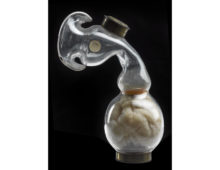Tagged with Transatlantic Slavery
Resource : Description of a Slave Ship
Transatlantic slavery was a brutal system which forcibly shipped over twelve million Africans to the Americas and lasted over 300 years. It allowed African men, women and children to be stolen from their homeland, bought and sold as property and used to produce sugar, coffee, cotton and other goods for huge profit in the European and North American markets. This print was made to highlight the inhumane conditions under which enslaved Africans were transported across the Atlantic Ocean, forced to make the long voyage from West Africa to the Americas, tightly packed into the hold of ships and held in chains.
Resource : “Waterloo Teeth”
This set of dentures is fitted with real human teeth, extracted from the mouths of dead soldiers.
Resource : Cotton kerchief (headwrap)
The headwrap originated in sub-Saharan Africa. For centuries, it has been worn by women in different African countries and regions, in different forms, to reflect both communal and personal identities – which clan or tribe they belonged to, whether they were married, widowed, young or old, for example. This cotton kerchief, or headwrap, belonged to Nancy Burns (1800 – 1849). Born in Albany, New York, the daughter of slaves, she would eventually find work as a house servant and was painted in a portrait wearing the item in the 1840s. It represents a long history of cultural identity associated with women of African origin – particularly African-American women – that is still very much alive today.
Resource : Ira Aldridge as Othello, the Moor of Venice
Ira Aldridge (1807 – 1867) was the first Black actor to play leading Shakespearian roles on the stage, both in Britain and across Europe.
Resource : Phillis Wheatley, Poems on various subjects, religious and moral
Phillis Wheatley was a talented poet who acquired international renown and became the first black woman in both Britain and the USA to have a book published. Her Poems on Various Subjects, Religious and Moral was published in 1773, the year in which she was manumitted from slavery and became free. Her personal circumstances did not improve with the change in status, and she died in poverty aged 31, but her revolutionary writing has endured.
Resource : Drawer handle with abolitionist plaque
In the late 1700s, the image of a kneeling, enslaved African man, accompanied by the words ‘Am I not a man and a brother’ became the most prominent emblem for those wishing to abolish the Transatlantic slave trade, in both Britain and America. As well as appearing in books, prints and pamphlets, it was also reproduced on an extraordinary variety of everyday and household items – from crockery and soft furnishings, to jewellery and hairpins.
Resource : Hannah More (1745 – 1833)
Hannah More (1745-1833) was a poet, playwright, anti-slavery campaigner and one of the most influential female philanthropists of the Age of Revolution. Seen by some as an early feminist, and others as an anti-feminist, she remains a controversial figure today.
Resource : The Battle of Vertières
In the late 1700s, the western part (St. Domingue) of the Caribbean island of Hispaniola was under French colonial rule. It had long been a major centre of sugar production on plantations using enslaved African labour. In 1791, Toussaint Louverture led the first – and only – successful uprising of slaves, in St Domingue. After a series of bloody conflicts and traumas with European colonial powers, St Domingue was renamed Haïti and became the first independent Black republic in 1804. These events became known as the Haitian revolution and played an important role in the decline of the Transatlantic slave trade. This lithograph depicts the Battle of Vertières in 1803, the final engagement between Haiti’s revolutionaries and Napoleon’s French forces.
Resource : Skelmanthorpe Flag
The 1800s saw a series of protests and uprisings in Britain, as people campaigned against slavery, unjust taxes and laws imposed by the government and in support of fair wages, the right to vote and to have their voices heard in parliament. Protest flags, posters and banners carrying radical slogans were a popular way for campaigners to get their message across at marches and rallies, and to cooperate without endangering individuals. The Skelmanthorpe flag was created in secret, in Huddersfield, initially to honour the victims of what became known as the Peterloo Massacre, in 1819.
Resource : William Wilberforce speaking out against slavery in the House of Lords
The movement to abolish the Transatlantic slave trade was a long and difficult struggle. Campaigners for abolition used every means they could, including sugar boycotts, meetings, petitions, publications, and circulating images showing its shameful nature, to bring the issue to people’s attention in Europe. Enslaved Africans played an essential part, having long resisted their enslavement and treatment through ‘go-slows’, revolts, intellectual and religious claims, and demonstrable capacity to retain and transmit their African or creole (mixed) cultures and languages. Escaped or freed slaves forced judges and social elites to confront the issue through court cases, publications, and performances. Propelled by much of this pressure and evidence, William Wilberforce led the long political campaign to outlaw the slave trade in Britain.


